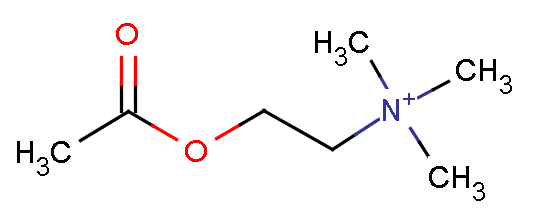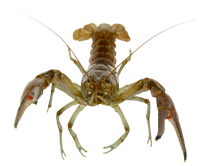Behavioral Neuroscience, lecture on Acetylcholine
Escape - Crayfish
VI. Acetylcholine (ACh)
 A. substrates: choline and acetyl CoA
(diet) (Glycolysis and Kreb's)
1. synthetic enzyme: choline acetyltransferase (CAT)
a. cytosolic (most is synaptic)
i. vesicular transporter = vAChT necessary
(1) package ACh for synaptic release
b. CoA left over
2. degradative enzyme: acetylcholine esterase (AChE)
a. membrane protein
b. catabolites = choline and acetate
c. turnover = 150ms or 5,000 ACh molecules/s
B. Muscarinic and Nicotinic Receptors (membrane proteins)
1. muscarinic M1 - M5 7tm
a. slow response time (100 - 250 ms)
b. act directly on ion channels
i. open or close K+, Ca++, or Cl- channels
(1) may lead to depolarization
or hyperpolarization
c. and activate 2nd messenger system (via G proteins)
i. M1,3,5 Gp(q)àñPLCàñIP3 & Ca++
ii. M2,4 GiàòACàòcAMP àò PKA àò CREB àò CRE
2. Nicotinic
a. four glycosylated peptide chains a, b, g, d in muscle
i. arranged with 2 a and 1 each b, g, d = 5 total
b. neuronal only a & b
i. arranged with 8 types of a + 3 types of b
c. ACh binds to the a subunit
i. binding causes conformational change
1) allows cations, not anions, to pass
a) Na+ pases first,
depolarizing muscle cell membrane
2) deporlarization à Ca++ release
from ER stimulates muscular contraction
C. Central ACh Distribution in vertebrates: Involved in Learning
1. ACh is produced in the nucleus basalis
a. projections to the cerebral cortex and many parts of the brain
b. these cells degenerate during Alzheimer's disease
2. ACh is in 2 specific populations in the limbic system
a. septum to hippocampus & habenulo-endopeduncular projections
b. short axon striatal cells
D. Autonomic NS
1. all sympathetic and parasympathetic preganglionic neurons
2. parasympathetic postganglionic neurons
E. ACh in Crayfish: transmitter for mechanosensory neurons
1. sensory neurons in vertebrates use Glu
2. sensory neurons in some other invertebrates (leeches) are glutamatergic
F. ACh as a transmitter for motor actions and coordination
1. motor neurons
\ all skeletal neuromuscular junctions
a. Invertebrates
i. crayfish: motor neurons to abdominal muscles
ii. Leech L, VE, DE, AE, HE
iii. Aplysia gill and siphon retraction
b. Vertebrates motoneurons of the spinal cord
2. Cells in the caudate-putamen nucleus involved in motor coordination
3. PPT and LPT innervation of substantia nigra
A. substrates: choline and acetyl CoA
(diet) (Glycolysis and Kreb's)
1. synthetic enzyme: choline acetyltransferase (CAT)
a. cytosolic (most is synaptic)
i. vesicular transporter = vAChT necessary
(1) package ACh for synaptic release
b. CoA left over
2. degradative enzyme: acetylcholine esterase (AChE)
a. membrane protein
b. catabolites = choline and acetate
c. turnover = 150ms or 5,000 ACh molecules/s
B. Muscarinic and Nicotinic Receptors (membrane proteins)
1. muscarinic M1 - M5 7tm
a. slow response time (100 - 250 ms)
b. act directly on ion channels
i. open or close K+, Ca++, or Cl- channels
(1) may lead to depolarization
or hyperpolarization
c. and activate 2nd messenger system (via G proteins)
i. M1,3,5 Gp(q)àñPLCàñIP3 & Ca++
ii. M2,4 GiàòACàòcAMP àò PKA àò CREB àò CRE
2. Nicotinic
a. four glycosylated peptide chains a, b, g, d in muscle
i. arranged with 2 a and 1 each b, g, d = 5 total
b. neuronal only a & b
i. arranged with 8 types of a + 3 types of b
c. ACh binds to the a subunit
i. binding causes conformational change
1) allows cations, not anions, to pass
a) Na+ pases first,
depolarizing muscle cell membrane
2) deporlarization à Ca++ release
from ER stimulates muscular contraction
C. Central ACh Distribution in vertebrates: Involved in Learning
1. ACh is produced in the nucleus basalis
a. projections to the cerebral cortex and many parts of the brain
b. these cells degenerate during Alzheimer's disease
2. ACh is in 2 specific populations in the limbic system
a. septum to hippocampus & habenulo-endopeduncular projections
b. short axon striatal cells
D. Autonomic NS
1. all sympathetic and parasympathetic preganglionic neurons
2. parasympathetic postganglionic neurons
E. ACh in Crayfish: transmitter for mechanosensory neurons
1. sensory neurons in vertebrates use Glu
2. sensory neurons in some other invertebrates (leeches) are glutamatergic
F. ACh as a transmitter for motor actions and coordination
1. motor neurons
\ all skeletal neuromuscular junctions
a. Invertebrates
i. crayfish: motor neurons to abdominal muscles
ii. Leech L, VE, DE, AE, HE
iii. Aplysia gill and siphon retraction
b. Vertebrates motoneurons of the spinal cord
2. Cells in the caudate-putamen nucleus involved in motor coordination
3. PPT and LPT innervation of substantia nigra

 A. substrates: choline and acetyl CoA
(diet) (Glycolysis and Kreb's)
1. synthetic enzyme: choline acetyltransferase (CAT)
a. cytosolic (most is synaptic)
i. vesicular transporter = vAChT necessary
(1) package ACh for synaptic release
b. CoA left over
2. degradative enzyme: acetylcholine esterase (AChE)
a. membrane protein
b. catabolites = choline and acetate
c. turnover = 150ms or 5,000 ACh molecules/s
B. Muscarinic and Nicotinic Receptors (membrane proteins)
1. muscarinic M1 - M5 7tm
a. slow response time (100 - 250 ms)
b. act directly on ion channels
i. open or close K+, Ca++, or Cl- channels
(1) may lead to depolarization
or hyperpolarization
c. and activate 2nd messenger system (via G proteins)
i. M1,3,5 Gp(q)àñPLCàñIP3 & Ca++
ii. M2,4 GiàòACàòcAMP àò PKA àò CREB àò CRE
2. Nicotinic
a. four glycosylated peptide chains a, b, g, d in muscle
i. arranged with 2 a and 1 each b, g, d = 5 total
b. neuronal only a & b
i. arranged with 8 types of a + 3 types of b
c. ACh binds to the a subunit
i. binding causes conformational change
1) allows cations, not anions, to pass
a) Na+ pases first,
depolarizing muscle cell membrane
2) deporlarization à Ca++ release
from ER stimulates muscular contraction
C. Central ACh Distribution in vertebrates: Involved in Learning
1. ACh is produced in the nucleus basalis
a. projections to the cerebral cortex and many parts of the brain
b. these cells degenerate during Alzheimer's disease
2. ACh is in 2 specific populations in the limbic system
a. septum to hippocampus & habenulo-endopeduncular projections
b. short axon striatal cells
D. Autonomic NS
1. all sympathetic and parasympathetic preganglionic neurons
2. parasympathetic postganglionic neurons
E. ACh in Crayfish: transmitter for mechanosensory neurons
1. sensory neurons in vertebrates use Glu
2. sensory neurons in some other invertebrates (leeches) are glutamatergic
F. ACh as a transmitter for motor actions and coordination
1. motor neurons
\ all skeletal neuromuscular junctions
a. Invertebrates
i. crayfish: motor neurons to abdominal muscles
ii. Leech L, VE, DE, AE, HE
iii. Aplysia gill and siphon retraction
b. Vertebrates motoneurons of the spinal cord
2. Cells in the caudate-putamen nucleus involved in motor coordination
3. PPT and LPT innervation of substantia nigra
A. substrates: choline and acetyl CoA
(diet) (Glycolysis and Kreb's)
1. synthetic enzyme: choline acetyltransferase (CAT)
a. cytosolic (most is synaptic)
i. vesicular transporter = vAChT necessary
(1) package ACh for synaptic release
b. CoA left over
2. degradative enzyme: acetylcholine esterase (AChE)
a. membrane protein
b. catabolites = choline and acetate
c. turnover = 150ms or 5,000 ACh molecules/s
B. Muscarinic and Nicotinic Receptors (membrane proteins)
1. muscarinic M1 - M5 7tm
a. slow response time (100 - 250 ms)
b. act directly on ion channels
i. open or close K+, Ca++, or Cl- channels
(1) may lead to depolarization
or hyperpolarization
c. and activate 2nd messenger system (via G proteins)
i. M1,3,5 Gp(q)àñPLCàñIP3 & Ca++
ii. M2,4 GiàòACàòcAMP àò PKA àò CREB àò CRE
2. Nicotinic
a. four glycosylated peptide chains a, b, g, d in muscle
i. arranged with 2 a and 1 each b, g, d = 5 total
b. neuronal only a & b
i. arranged with 8 types of a + 3 types of b
c. ACh binds to the a subunit
i. binding causes conformational change
1) allows cations, not anions, to pass
a) Na+ pases first,
depolarizing muscle cell membrane
2) deporlarization à Ca++ release
from ER stimulates muscular contraction
C. Central ACh Distribution in vertebrates: Involved in Learning
1. ACh is produced in the nucleus basalis
a. projections to the cerebral cortex and many parts of the brain
b. these cells degenerate during Alzheimer's disease
2. ACh is in 2 specific populations in the limbic system
a. septum to hippocampus & habenulo-endopeduncular projections
b. short axon striatal cells
D. Autonomic NS
1. all sympathetic and parasympathetic preganglionic neurons
2. parasympathetic postganglionic neurons
E. ACh in Crayfish: transmitter for mechanosensory neurons
1. sensory neurons in vertebrates use Glu
2. sensory neurons in some other invertebrates (leeches) are glutamatergic
F. ACh as a transmitter for motor actions and coordination
1. motor neurons
\ all skeletal neuromuscular junctions
a. Invertebrates
i. crayfish: motor neurons to abdominal muscles
ii. Leech L, VE, DE, AE, HE
iii. Aplysia gill and siphon retraction
b. Vertebrates motoneurons of the spinal cord
2. Cells in the caudate-putamen nucleus involved in motor coordination
3. PPT and LPT innervation of substantia nigra